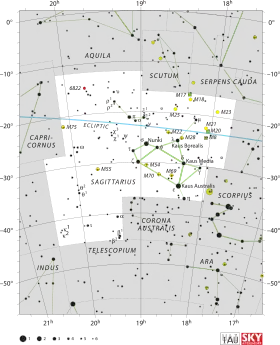Nu2 Sagittarii
Nu2 Sagittarii (ν2 Sagittarii) is a binary star[8] system in the zodiac constellation of Sagittarius. It is faintly visible to the naked eye, having an apparent visual magnitude of +4.98;[2] it is 0.16 degree north of the ecliptic. The annual parallax shift of 11.91 mas as seen from Earth,[1] indicates this system is roughly 270 light years from the Sun. Nu2 Sagittarii has a high peculiar velocity of 86.0+11.6
−14.4 km/s and is most likely a runaway star system.[3]

| |
| Observation data Epoch J2000.0 Equinox J2000.0 (ICRS) | |
|---|---|
| Constellation | Sagittarius |
| Right ascension | 18h 55m 07.14098s[1] |
| Declination | −22° 40′ 16.8185″[1] |
| Apparent magnitude (V) | +4.98[2] |
| Characteristics | |
| Spectral type | K1 Ib–II[3] |
| B−V color index | +1.32[2] |
| Astrometry | |
| Radial velocity (Rv) | −109.6[2] km/s |
| Proper motion (μ) | RA: −109.04[1] mas/yr Dec.: −35.25[1] mas/yr |
| Parallax (π) | 11.91 ± 0.52[1] mas |
| Distance | 270 ± 10 ly (84 ± 4 pc) |
| Absolute magnitude (MV) | +0.38[4] |
| Details | |
| ν2 Sgr A | |
| Mass | 1.44[2] M☉ |
| Radius | 85[5] R☉ |
| Luminosity | 120[2] L☉ |
| Surface gravity (log g) | 1.03[6] cgs |
| Temperature | 4,244±57[2] K |
| Metallicity [Fe/H] | −0.13[6] dex |
| Age | 4.52[2] Gyr |
| Other designations | |
| Database references | |
| SIMBAD | data |
The spectrum of the primary component displays a stellar classification of K1 Ib–II,[3] indicating this is a K-type star with a mixed luminosity class of an evolved bright giant/supergiant star. It is a mild barium star, showing an enhanced abundance of s-process elements in its outer atmosphere. This material was most likely acquired during a previous mass transfer from its now white dwarf companion.[9] The primary has an estimated 1.4[2] times the mass of the Sun and has expanded to 85[5] times the Sun's radius.
References
- van Leeuwen, F. (2007), "Validation of the new Hipparcos reduction", Astronomy and Astrophysics, 474 (2): 653–664, arXiv:0708.1752, Bibcode:2007A&A...474..653V, doi:10.1051/0004-6361:20078357.
- Luck, R. Earle (2015), "Abundances in the Local Region. I. G and K Giants", Astronomical Journal, 150 (3), 88, arXiv:1507.01466, Bibcode:2015AJ....150...88L, doi:10.1088/0004-6256/150/3/88.
- Tetzlaff, N.; et al. (January 2011), "A catalogue of young runaway Hipparcos stars within 3 kpc from the Sun", Monthly Notices of the Royal Astronomical Society, 410 (1): 190–200, arXiv:1007.4883, Bibcode:2011MNRAS.410..190T, doi:10.1111/j.1365-2966.2010.17434.x.
- Anderson, E.; Francis, Ch. (2012), "XHIP: An extended hipparcos compilation", Astronomy Letters, 38 (5): 331, arXiv:1108.4971, Bibcode:2012AstL...38..331A, doi:10.1134/S1063773712050015.
- Pasinetti Fracassini, L. E.; et al. (2001), "Catalogue of Apparent Diameters and Absolute Radii of Stars (CADARS)", Astronomy & Astrophysics (3rd ed.), 367: 521–24, arXiv:astro-ph/0012289, Bibcode:2001A&A...367..521P, doi:10.1051/0004-6361:20000451.
- Soubiran, C.; et al. (June 2010), "The PASTEL catalogue of stellar parameters", Astronomy and Astrophysics, 515: A111, arXiv:1004.1069, Bibcode:2010A&A...515A.111S, doi:10.1051/0004-6361/201014247.
- "nu02 Sgr". SIMBAD. Centre de données astronomiques de Strasbourg. Retrieved 2017-07-06.
- Eggleton, P. P.; Tokovinin, A. A. (September 2008), "A catalogue of multiplicity among bright stellar systems", Monthly Notices of the Royal Astronomical Society, 389 (2): 869–879, arXiv:0806.2878, Bibcode:2008MNRAS.389..869E, doi:10.1111/j.1365-2966.2008.13596.x.
- Gomez, A. E.; et al. (1997), "Absolute magnitudes and kinematics of barium stars", Astronomy and Astrophysics, 319: 881, Bibcode:1997A&A...319..881G.